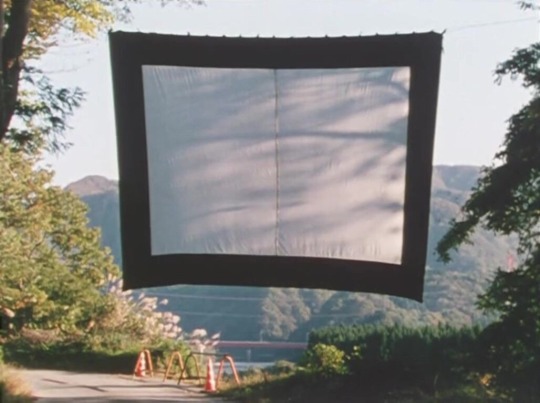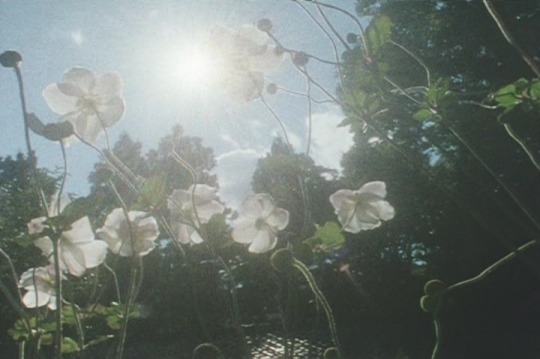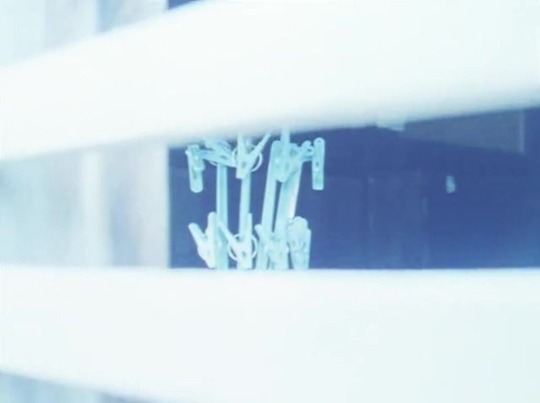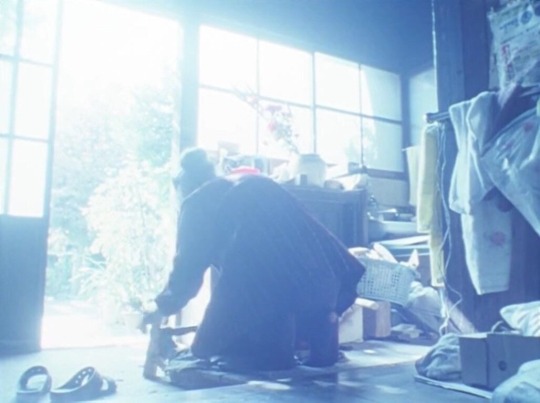#Memories of Agano
Text





Memories of Agano (阿賀の記憶), Makoto Satō, 2005
13 notes
·
View notes
Photo

Memories of Agano (Sato Makoto, 2005) a decade after making his first documentary on the area, he returns. not to push anything forward, but to reconnect with the (remaining) people and the life he and his crew had there. much more an abstract, personal work than the first film. and maybe even a better work. recording and reviving impressions and memories. songs are sung, stories are told, hospotality is shared, steps are retraced, wind blows, snow falls, scenes from the first film are projected on sheets outside in the fields and river banks. the people speak with a thick regional dialect. the subtitles help with this by only translating what's intelligible to standard japanese, so you get lines like "something about cement...". a wonderful, human touch to a wonderful, human film made by a wonderful human.
3 notes
·
View notes
Photo








Memories of Agano (阿賀の記憶), Makoto Satō, 2005
54 notes
·
View notes
Photo

\おにわさん更新情報📸/ [ 新潟県阿賀野市 ] 吉田東伍記念博物館庭園 Yoshida Togo Memorial Museum's Garden, Agano, Niigata の写真・記事を更新しました。 ――日本の歴史地理学のパイオニア #吉田東伍 の生家である明治・大正期の屋敷と苔と石組の美しい中庭。 ・・・・・・・・ 吉田東伍記念博物館は近代に活躍した地理学者・吉田東伍の生家とそれに隣接した建物を利用した博物館。 2019年のGWに新潟・安田の街に行った経緯は孝順寺(旧斉藤家本邸)の方に書いたけど――簡潔に言うと「新潟市内で宿が取れなくてたまたま安田で宿が取れたから」。 そこで「ああ、ちょうど孝順寺があるからそこ寄ろう」と決めた上で、地図で見てたらこの…古民家を活用したような博物館があることにも気付いて、寄ってみようと。 安田は江戸時代には #安田藩 の城下町🏯であり(短命だったけど)、宿場町でもありました。 現在も多少古い町並みの雰囲気が残っており――街道沿いのこの博物館もその一つ。孝順寺からは徒歩5分程。 まず吉田東伍について。勉強不足で自分は知らなかったのですが――明治時代に13年もかけて日本全国の地名の変遷・由来・風土をまとめた『大日本地名辞書』の著者で、日本の歴史地理学のパイオニア的存在📚 ……と言われても正直ピンと来ないかもしれないけど、その序文には大隈重信、渋沢栄一、新渡戸稲造らをはじめとする政治家から作家まで著名人が名を連ねています。 吉田東伍は当地の豪農・旗野家の出身(吉田姓は婿養子に入った先の姓)。この旗野家は「角屋」という屋号で、保田の街でも屈指の山林地主であり、また質屋・酒造業も営んでいたそう。 現在も残る屋敷は明治時代に造られ、その後大正時代に改修を経たものとのこと。なのでこの中庭も明治・大正期の名残なのかなあと…規模は(他の新潟の #豪農屋敷 と比べると)決して大きいものではないですが、きれいな苔🌿と飛び石の雰囲気は阿賀野〜新発田のそれ以外の庭園と似たものを感じる。 なお新発田の豪農・市島家は吉田東伍や旗野家にとっても親戚にあたったそうで、先の『大日本地名辞書』の編さんにあたっても資金援助をする関係にあったとか。(パトロン的存在?) 安田には孝順寺やこの旧旗野家以外にも雰囲気のある大きな商家が残されている――あと寺社仏閣も集落ごとにあったりするので。まだ知られていない庭園があったりするんだろうなあ――いつかまた訪れたい町! 〜〜〜〜〜〜〜〜 🔗おにわさん記事URL: https://oniwa.garden/yoshida-togo-museum-%e5%90%89%e7%94%b0%e6%9d%b1%e4%bc%8d%e8%a8%98%e5%bf%b5%e5%8d%9a%e7%89%a9%e9%a4%a8/ ーーーーーーーー #庭園 #日本庭園 #garden #japanesegarden #japanesegardens #zengarden #新潟 #新潟県 #niigata #阿賀野 #阿賀野市 #agano #水原 #安田 #安田町 #yasuda #博物館 #museum #おにわさん (吉田東伍記念博物館) https://www.instagram.com/p/B0hrEfjgKVc/?igshid=1v8k9142c3qup
#吉田東伍#安田藩#豪農屋敷#庭園#日本庭園#garden#japanesegarden#japanesegardens#zengarden#新潟#新潟県#niigata#阿賀野#阿賀野市#agano#水原#安田#安田町#yasuda#博物館#museum#おにわさん
0 notes
Text
Taffy 3 and Hatsuzuki
In the history of naval warfare, two battles stand alone, one whose fame has been sung for nearly a century, the other whose name is nearly unknown. I think of one when I think of the other, for both happened on the same day, in the same archipelago, between the same navies, for similar reasons, with similar results, resulting from similar ferocity on the part of each, such that their opponents mistook them for ships far beyond their true size.
One is the US Navy 7th Fleet Task Force 77.4.3, more often known by the name "Taffy 3." A comparatively small force, just a few destroyers, destroyer escorts, and escort carriers, each designed mostly to fight submarines, repurposed to fight ground troops, and yet -- when it came time to do battle it was not with submarines nor ground troops. It was against the Center Force of the Imperial Japanese Navy, an assembly of the largest and most powerful battleships ever made, each of which outweighed any ship in Taffy 3, one of which outweighed all of Taffy 3 combined. Each cannon of the battleship Yamamoto weighed as much as the destroyers arrayed against her. Alongside her sailed three other battleships, six heavy cruisers, two light cruisers, and eleven destroyers.
And they were sailing to intercept a group of troop transports, an entire division of U.S. Marines, none of whom would have survived if Center Force found them, for Admiral Halsey, the commander of the U.S. fleet, had taken his ships chasing after shadows. So, it was up to Taffy 3, and Taffy 3 alone, to stand in the way.
The valiance and sheer audacity of their defense, along with compounding errors on the part of the Japanese admiral, and Center Force's inability to respond to air attacks, led the Japanese fleet to turn away from a force that, by all logic, by all sense, by every war game one could play, should have been little more than a tin can against a tank. But for the captains of Taffy 3 there was no sense, only desperation, grim resolve and wild fury. The little escort force made it abundantly clear just why the name berserker still rings through the ages, why it still sends shivers down the spine. For one who fights without retreat, and without thought of surrender, is the most terrifying opponent possible.
And for all that the destroyers were sunk, their engines in pieces and their sailors slain -- they won. They gave everything they had to save the troop transports and it was enough. Kurita turned his fleet away. It has been called the most lopsided battle in the history of naval warfare. Perhaps the most lopsided victory in all of human history, though some would hold Simö Hayha's Winter War service up to the same level.
The difference being that Hayha was only hit once, whereas the ships of Taffy 3 were hit many times by shells that should have sunk them in an instant, and they never stopped fighting, not until the very end. Captain Evans shouted orders down to the men handling the rudder when his bridge was out of commission. Paul H. Carr died at his post with one unfired round still in hand.. Fighter pilots ran at the enemy ships with machine gun fire, with depth charges, with rockets, with handguns, with nothing at all but dry runs. Everyone gave everything they could, and it was enough.
The tin can stopped the tank.
Admiral Sprague’s record of the battle includes a quotation from an unnamed signal officer near him, which stands in perfect summation of the spirit of Taffy 3. In the context of the battle, the quotation stands as the most audacious epigram in the history of warfare, for upon seeing the retreat of the Japanese fleet, the sailor shouted:
Damn it, boys, they’re getting away!
That was the spirit that defeated Admiral Kurita.
...
There is another ship amidst the battles of Leyte Gulf that day, who matched Taffy 3 in spirit and in sacrifice, if not in renown.
To the level of Taffy 3 I will hold a ship few if any remember, whose commander left no words we remember, whose crew left no words the Anglosphere has ever recorded. To the level of Taffy 3 I will hold the destroyer Hatsuzuki.
Of the Northern Force that met Halsey’s fleet in battle up near Cape Engaño, there were survivors. Perhaps few more than the 2360 loaded onto ships that Hatsuzuki escorted. But whatever ship did hold survivors, it could not risk these passengers in open battle, not when the decks were crowded with non-combatants. For the group that Hatsuzuki was escorting, only she could meet the pursuit of the enemy ships head-on. She had loaded the fewest survivors; she had her decks clear; she had her guns ready.
And so she met her enemies.
She did not turn aside her opponent, only delayed them. She did not save the fortunes of her navy, only the lives of a few soldiers. And yet -- in her own victory that day, she stands with Taffy 3.
I say victory. For she was ONE ship, one lone destroyer, without air cover, without an opponent as timid as Admiral Kurita. She stood alone, against many US cruisers and destroyers, buying time for the rest of her group to get away. For two hours she stood alone, and held off an opponent that outweighed her and outgunned her as much as the Yamato outweighed Taffy 3. For two hours she held, for the sake of the survivors, lest they perish after they thought they were saved.
Two hours were all she could give, before she fell. But those hours were enough.
There is very little we know of the battle itself, other than that it was a “very stubborn fight”; if I were to say what the crew of the Hatsuzuki felt, and what their captain said, it would be speculation, unless by some miracle the accounts of the few survivors are preserved in Japanese texts, somewhere. Therefore I can only speak of what we do know -- but what we do know, and what we may know, is enough to venture some speculation.
What we do know: for two hours she held the line against many foes, and, just as Taffy 3 was mistaken for an entire fleet, she was mistaken many times for a heavy cruiser.
As for what we may know -- I will admit that ModelShipwrights.com is hardly an authoritative source, especially when the passage in question cites no sources. Yet it is the only online source I have been able to find with an actual description of Hatsuzuki’s last stand. As follows:
As Hatsuzuki was rescuing the survivors along with sister destroyer Wakasuki and the smaller Kuwa, the group was surprised by a U.S. force of four cruisers and three destroyers...Captain Amano Shigetaka detached Hatsuzuki to attack the U.S. force to cover the escape of Wakasuki and Kuwa. In a two hour running battle the fast, agile ship made repeated real and feint torpedo attacks and fired her guns continuously, managing to straddle the cruiser Santa Fe and shower the Wichita with splinters. More importantly, these all-out attacks distracted the U.S. force as Wakasuki and Kuwa withdrew. The destroyer put up such a fight that American observers identified the ship variously as an Aoba-class heavy cruiser or an Agano-class light cruiser – but the end was inevitable. The lone ship was, in the words of a USN battle report, “literally punched to pieces” under the combined firepower of four cruisers and three destroyers. All aboard Hatsuzuki, including the Destroyer Division Commander, perished. Nevertheless, the sacrifice enabled Wakasuki and Kuwa with their deckloads of survivors as well as the light cruiser Isuzu (which had been assisting the sinking carrier Chiyoda), to escape.
This account does not square precisely with Wikipedia’s description, which has the opposing force as 13 ships rather than seven. But, either way, it is clear that the Hatsuzuki went down fighting hard. If I am to believe the details of this this report, then I can believe that Captain Shigetaka had the same steely resolve as Captain Evans, and that Hatsuzuki’s crew had the same tenacity as that of the USS Johnston. I should think they would need both to stand against so many foes, whether seven or thirteen.
The detail that shines through all accounts is what connects her so closely to Taffy 3: that she fought so boldly as to make her appearance far outweigh her physical substance in the eyes of her enemy.
It is not easy for an experienced sailor to mistake a destroyer for a heavy cruiser; the former tops out at far less than half the tonnage of the latter. Even in her single photograph, she does not appear large or imposing, compared to a cruiser.
I daresay that her crew made up for the difference by spending everything they had. I daresay that she, like Taffy 3, earned the title of Berserker, in her desperate battle to save the survivors of Engaño. For the sake of those survivors, she was a roaring tiger where her foes thought they had met a mouse.
I consider what navies, what armies, what cavalries have done the same. A few come to mind. We forget sometimes that the Greek armies held Thermopylae against the Persians to give the people of Athens more time to escape. Likewise the combined 9th and 12th armies of the Wehrmacht stood against the advancing Soviets to buy as much time for fleeing refugees as they could. In the Pacific War, the destroyer Akikaze deliberately took the blow of a salvo of torpedos heading towards an escort carrier, and was lost with all hands. From our own time there are a fair few individuals who have done the same -- those lone people who, in the ongoing war of the far-right wing against the idea of a peaceful society, stood up to mass shooters and held them off long enough for others to escape.
I wonder how many such examples have been lost to memory. On that I can only speculate -- that as the defenseless are menaced, so there are always those willing to stand in their defense? Many times I think human beings are eager for it. Perhaps too eager, too eager to die as an easy path, rather than live for people as the harder path -- tempting to die and escape, rather than live and suffer. Yet there are times when one can only die for others or run away, and while some will run, others will hold the line as long as they can, whether or not they will be remembered. As if by instinct, rather than deliberation.
No one had to convince the crews of Taffy 3 and Hatsuzuki to do this. No one had to whip them forward, no one had to promise them heavenly reward or hellish punishment. All they needed was to know that there were people in the line of fire who could not fire back and would be fired upon, if someone did not stand in the way. All they needed to know was that they were the only people close enough to be that someone. And they knew that they would die in this defense.
And every one of them said:
What are we waiting for?
...
I will speak of Hatsuzuki and Taffy 3 as equals, in the same breath, rarely to mention one without the other. And if anyone should ask why, I say:
They stood alone in defense of the the defenseless.
And that answer should be enough.
#Taffy 3#Hatsuzuki#battle of leyte gulf#heroic sacrifice#a heroic sacrifice gladly met and grandly done#I often imagine a sailor aboard the USS Samuel B Roberts#Hearing the words of his captain#the warning of the coming battle and the resolve to fight to the end#seeing his ship sail straight towards the Yamato#and saying#YEEEEEEEEEE HAW
1 note
·
View note
Photo


Memories of Agano (阿賀の記憶), Makoto Satō, 2005
21 notes
·
View notes
Photo

Lists!
Best new to me - 2019
Good Riddance (Francis Mankiewicz, 1980)
Twilight (Fehér György, 1990)
‘R Xmas (Abel Ferrera, 2001)
Just a Boys’ Game (John Mackenzie, 1979)
Three Days (Sharunas Bartas, 1992)
Uski Roti (Mani Kaul, 1969)
Memories of Agano (Sato Makoto, 2005)
Crashout (Lewis R. Foster, 1955)
Sleeping Man (Oguri Kohei, 1995)
The Headless Woman (Lucrecia Martel, 2008)
The Crazy-Quilt (John Korty, 1966)
Verboten! (Samuel Fuller, 1959)
The Baby of Mâcon (Peter Greenaway, 1993)
Girlfriend: Someone Please Stop the World (Hiroki Ryuichi, 2004)
Man on the Roof (Bo Widerberg, 1976)
Far from Home (Sohrab Shahid Saless, 1975)
The Memory of Justice (Marcel Ophüls, 1976)
When the Tenth Month Comes (Minh Dang Nhat, 1984)
Death in the Land of Encantos (Lav Diaz, 2007)
Africa’s Light (Kumashiro Tatsumi, 1975)
Best to me from 2019 (or 2018)
High Life (Claire Denis, 2018)
Ham on Rye (Tyler Taormina, 2019)
The Wolf House (Joaquín Cociña & Cristóbal León, 2018)
I Was at Home, But… (Angela Schanelec, 2019)
Portrait of a Lady on Fire (Céline Sciamma, 2019)
Parasite (Bong Joon-ho, 2019)
Ad Astra (James Gray, 2019)
The Beach Bum (Harmony Korine, 2019)
Another Child (Kim Yoon-seok, 2019)
Siblings of the Cape (Katayama Shinya, 2018)
Best to me from 2010-19 (more or less chronologically)
Oki’s Movie (Hong Sang-soo, 2010)
Poetry (Lee Chang-dong, 2010)
Le Havre (Aki Kaurismaki, 2011)
Kotoko (Tsukamoto Shinya, 2011)
Spring Breakers (Harmony Korine, 2012)
Stop the Pounding Heart (Roberto Minervini, 2013)
Mary is Happy, Mary is Happy (Nawapol Thamrongrattanarit, 2013)
The Strange Little Cat (Ramon Zürcher, 2013)
Hit 2 Pass (Kurt Walker, 2014)
A Midsummer's Fantasia (Jang Kun-jae, 2014)
Entertainment (Rick Alverson, 2015)
Mad Max: Fury Road (George Miller, 2015)
Cemetery of Splendour (Apichatopong Weerasethakul, 2015)
American Honey (Andrea Arnold, 2016)
Antiporno (Sono Sion, 2016)
By the Time It Gets Dark (Anocha Suwichakornpong, 2016)
Toni Erdman (Maren Ade, 2016)
The Wolf House (Joaquín Cociña & Cristóbal León, 2018)
High Life (Claire Denis, 2018)
12 notes
·
View notes





